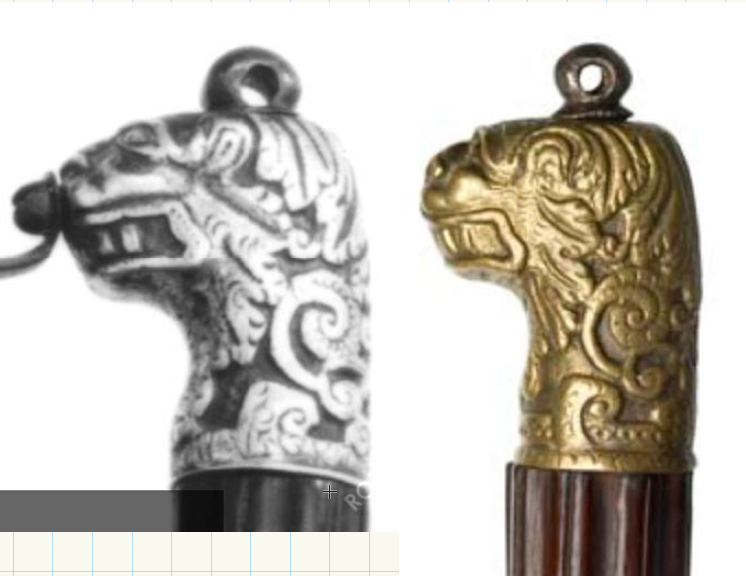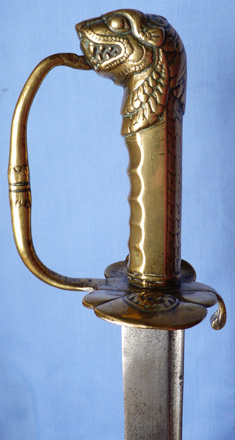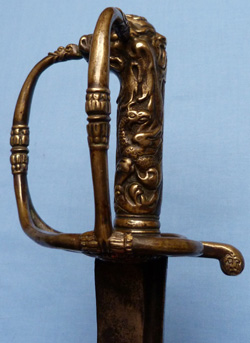I've recently come across several swords that share a number of hilt construction methods and styles. I'm hesitant to call them a "type," because none of them look alike, but they all have fluted wood grips, brass lion head pommels and sheet iron guards, and most of them have flat quillons, and flat knucklebows that are screwed to the pommels.
These two are dated to the mid-17th century:
https://collections.royalarmouries.org/object/rac-object-158.html
https://collections.royalarmouries.org/object/rac-object-76.html
This one is said to be early 18th century:
https://www.clevelandart.org/art/1916.1627
The pommel appears to be the top quarter or so of a lion head pommel, or something very similar, with the grip carved to approximate the shape it would have if it were a full head.
The hilt on this one is more heavily shaped (the quillons aren't flat) and doesn't have a full knucklebow. It's said to be "dated 1634":
https://collections.museumoflondon.org.uk/online/object/109178.html
I'm e-mailing these museums to try to find out how the dates were established. In the meantime, what do you think? Do they seem correct? Are there other, well-provenanced examples that would corroborate them or suggest different dates? Basically, how long would you expect to see hilts with this combination of features being produced?
Hard to imagine these two didn't come from the same craftsperson....
[img][/img]
 Attachment: 402.94 KB
Attachment: 402.94 KB

[img][/img]

Hi Dan
In generalities, they are often regarded regarded in the English speaking communities and authors as hangers and cutlasses. There is some debate about the term "tuck" for these short swords but then one goes down the paths of etymology.
With some of the elements lasting more than two centuries, we do often rely on lettered authors. One could add the term "shell guard" and see developments of the 16th century and perhaps most notably with the late 1500s. See the crossovers from swords like walloons to the more stylized shells.
Which elements are you wondering about?
Some will regard beasties as an extension of the seafarers and eastern swords such as the kastane, The lion motif, bear, dog, dolphin studies in and of themselves.
Are the museums and authors right? They are probably better judges than most of us.
Construction methods don't change a whole lot during those centuries, so one might best date the work by stylings and blade forms.
Cheers
GC
In generalities, they are often regarded regarded in the English speaking communities and authors as hangers and cutlasses. There is some debate about the term "tuck" for these short swords but then one goes down the paths of etymology.
With some of the elements lasting more than two centuries, we do often rely on lettered authors. One could add the term "shell guard" and see developments of the 16th century and perhaps most notably with the late 1500s. See the crossovers from swords like walloons to the more stylized shells.
Which elements are you wondering about?
Some will regard beasties as an extension of the seafarers and eastern swords such as the kastane, The lion motif, bear, dog, dolphin studies in and of themselves.
Are the museums and authors right? They are probably better judges than most of us.
Construction methods don't change a whole lot during those centuries, so one might best date the work by stylings and blade forms.
Cheers
GC
| Jesse Belsky wrote: |
| Hard to imagine these two didn't come from the same craftsperson....
|
The two are similar but (to me) quite different. It may be aspect and angle confusing me. It is kind of like assigning all P guard sabres as British 1796 lc swords, or that all katana look alike.
By the 17th century, there was quite a bit of standardization going on. An example might be the British Royal Navy ordnance board looking for standardized cutlasses towards the end of the 1640s. Well before that, measures and decrees in England regarding arms and armour, along with import regulations. Steel qualities becoming more expected. I am sure elsewhere in Europe and even in the east.
By the 18th and 19th century, there was a lot of plain old copying and cloning going on. I may have a critical eye after twenty years of focusing on three or four decades of Americana but those decades center around 1800. Lion pommels on hangers go right through to the 20th century.
Cheers
GC
Thank you.
Maybe, but I could also see one as a copy of the other, or both as copies of yet another, etc. On close examination, they aren't from the same mold, in any case.
I suppose, paring it down as much as possible, the sheet iron clamshell guards of the first three swords, with the knucklebows and quillons left as almost flat bars and simply curved/rolled at the ends, in combination with that style of brass lion pommel. And maybe the straight fluted grips. Perhaps including the London sword sort of muddies the question; I was just adding another example that shares some of the features.
I did notice the Cleveland sword and the first Leeds one have many identical features of the blade, excepting that the Cleveland one is slightly curved. Maybe the same bladesmith? Very different dates, though. If the others are dated correctly, then I could believe the Cleveland one is dated incorrectly and is older, but I haven't gotten a reply from them yet.
The Museum of London wrote back to me already; they say that by "dated 1634" they mean the blade is actually inscribed 1634.
| Jesse Belsky wrote: |
| Hard to imagine these two didn't come from the same craftsperson.... |
Maybe, but I could also see one as a copy of the other, or both as copies of yet another, etc. On close examination, they aren't from the same mold, in any case.
| Glen A Cleeton wrote: |
| Which elements are you wondering about? |
I suppose, paring it down as much as possible, the sheet iron clamshell guards of the first three swords, with the knucklebows and quillons left as almost flat bars and simply curved/rolled at the ends, in combination with that style of brass lion pommel. And maybe the straight fluted grips. Perhaps including the London sword sort of muddies the question; I was just adding another example that shares some of the features.
| Glen A Cleeton wrote: |
| Construction methods don't change a whole lot during those centuries, so one might best date the work by stylings and blade forms. |
I did notice the Cleveland sword and the first Leeds one have many identical features of the blade, excepting that the Cleveland one is slightly curved. Maybe the same bladesmith? Very different dates, though. If the others are dated correctly, then I could believe the Cleveland one is dated incorrectly and is older, but I haven't gotten a reply from them yet.
The Museum of London wrote back to me already; they say that by "dated 1634" they mean the blade is actually inscribed 1634.
Dear Dan,
My understanding, heavily influenced by Stuart Mowbray's British Military Swords, Volume I: 1600 to 1660 The English Civil Wars and the Birth of the British Standing Army, is that the capstan-nut construction shared by all of these swords was typical of, and perhaps brought to Britain by, Johannes Kinndt, whose name appears in English as John Kennet. These all look to me like hangers from his shop, or copies of them. He was one of the Hounslow sword-cutlers, so most of his work falls between the mid-1630s (when Hounslow was established as a sword-making center) and the Civil Wars; as Hounslow was a royal establishment, it backed the wrong (i.e., losing; I'm not making judgements here) side in that conflict and suffered for it. Its location near London (it's actually been engulfed by London and is now within its borders), a Parliamentarian center, did not help. I believe that Hounslow was re-established after the war (my impression is that it never fully recovered, because many of the original craftsmen scattered and took up their trade in other locations), but is best known for pre-war work.
The dismounted example from the Royal Armouries (IX.1318) has what seems to me to be an atypical guard for this style of hanger, more akin to a mortuary sword's guard, which still would be contemporary to the other guards (the mortuary style, or English half-basket, was popular from about 1630 to about 1660, neatly bracketing the Civil Wars). The other three guards seem to be of the more usual type for these swords, although the downturned shell on the other R.A. example (IX.760) is probably later--maybe around 1660--than the upturned ones on the two non-R.A. swords to which you linked. I'd guess that the Cleveland example is indeed incorrectly dated, and is really a mid-seventeenth-century sword.
I know that some of the dating for Hounslow itself comes from the documents relating to its establishment, and I think that there are also extant contracts for work from its craftsmen. There may be legal records that pertain specifically to Kinndt, such as marriage records and a will, but I'm very vague about this and may be mistaken.
This is actually a well-established type of sword, generally known as a Hounslow hanger. They seem to have been popular as upper-class weapons around the time of and during the Civil Wars, and probably survived for a while after it as hunting weapons, but I'm not aware of any that share this construction and these features as late as the eighteenth century. In fact, I'd be surprised to see one dated as late as 1680.
I hope this proves helpful.
Best,
Mark Millman
My understanding, heavily influenced by Stuart Mowbray's British Military Swords, Volume I: 1600 to 1660 The English Civil Wars and the Birth of the British Standing Army, is that the capstan-nut construction shared by all of these swords was typical of, and perhaps brought to Britain by, Johannes Kinndt, whose name appears in English as John Kennet. These all look to me like hangers from his shop, or copies of them. He was one of the Hounslow sword-cutlers, so most of his work falls between the mid-1630s (when Hounslow was established as a sword-making center) and the Civil Wars; as Hounslow was a royal establishment, it backed the wrong (i.e., losing; I'm not making judgements here) side in that conflict and suffered for it. Its location near London (it's actually been engulfed by London and is now within its borders), a Parliamentarian center, did not help. I believe that Hounslow was re-established after the war (my impression is that it never fully recovered, because many of the original craftsmen scattered and took up their trade in other locations), but is best known for pre-war work.
The dismounted example from the Royal Armouries (IX.1318) has what seems to me to be an atypical guard for this style of hanger, more akin to a mortuary sword's guard, which still would be contemporary to the other guards (the mortuary style, or English half-basket, was popular from about 1630 to about 1660, neatly bracketing the Civil Wars). The other three guards seem to be of the more usual type for these swords, although the downturned shell on the other R.A. example (IX.760) is probably later--maybe around 1660--than the upturned ones on the two non-R.A. swords to which you linked. I'd guess that the Cleveland example is indeed incorrectly dated, and is really a mid-seventeenth-century sword.
I know that some of the dating for Hounslow itself comes from the documents relating to its establishment, and I think that there are also extant contracts for work from its craftsmen. There may be legal records that pertain specifically to Kinndt, such as marriage records and a will, but I'm very vague about this and may be mistaken.
This is actually a well-established type of sword, generally known as a Hounslow hanger. They seem to have been popular as upper-class weapons around the time of and during the Civil Wars, and probably survived for a while after it as hunting weapons, but I'm not aware of any that share this construction and these features as late as the eighteenth century. In fact, I'd be surprised to see one dated as late as 1680.
I hope this proves helpful.
Best,
Mark Millman
Very helpful, thank you. Though I have to admit being a little disappointed. I find it an eye-catching look and it would've been very cool if it had continued as late as the 1700s.
Dear Dan,
I'm happy to have been able to help a bit.
Yes, I'd be strongly inclined to think that no new ones were being produced that late.
But I'd be equally confident that at least some older gentlemen were still carrying a few of these into the eighteenth century as undress and hunting swords. These would be the same people who were still wearing the styles of their youth, rather than whatever was current at the time you have in mind. Even though it extends the style's lifespan, it probably does limit the latest use to the first quarter or third of the eighteenth century.
Do, or did, you have some project in mind involving this style of hanger?
Best,
Mark
I'm happy to have been able to help a bit.
Yes, I'd be strongly inclined to think that no new ones were being produced that late.
But I'd be equally confident that at least some older gentlemen were still carrying a few of these into the eighteenth century as undress and hunting swords. These would be the same people who were still wearing the styles of their youth, rather than whatever was current at the time you have in mind. Even though it extends the style's lifespan, it probably does limit the latest use to the first quarter or third of the eighteenth century.
Do, or did, you have some project in mind involving this style of hanger?
Best,
Mark
| Mark Millman wrote: |
| Do, or did, you have some project in mind involving this style of hanger? |
I was considering one for a couple years down the road. Need to improve my fabrication skills to make the guard, and save up for a custom blade and pommel.
But much as I like this style, my notion was for a sword that a younger person might've acquired around 1700, and one that was out of production for a long time by then doesn't seem like the right choice, even if there's an outside possibility.
I'm in full agreement with Glenn and Mark's comments: this style of hilt with it's (usually) brass lion head, the fluted wood grip, and the guard formed from a flattish sheet are English from the 1630s to (maybe) the 1670s. The Cleveland example is misdated, in my opinion.
If you wanted something closer to 1700, the type of hanger pictured below are dated from the late 1600s right up to about 1720. The example with the simple guard show a definite Kastane influence, as Glenn mentioned in one of his posts above.
--ElJay
 Attachment: 76.25 KB
Attachment: 76.25 KB

 Attachment: 65.31 KB
Attachment: 65.31 KB

If you wanted something closer to 1700, the type of hanger pictured below are dated from the late 1600s right up to about 1720. The example with the simple guard show a definite Kastane influence, as Glenn mentioned in one of his posts above.
--ElJay


Looks good -- I imagine a solid brass hilt would give it a close point of balance. Do you know if anyone is currently manufacturing them?
Hi Dan,
Here's a link: http://therifleshoppe.com/catalog_pages/knives_swords/(668).htm
I built one of these up for a collector about 8 years ago. The casting was OK, but the grip and pommel was a better casting than the guard. There was a lot of finish filing and detailing to do, but the end result looked alright, and as you surmised, the POB was pretty close to the hilt.
--ElJay
Here's a link: http://therifleshoppe.com/catalog_pages/knives_swords/(668).htm
I built one of these up for a collector about 8 years ago. The casting was OK, but the grip and pommel was a better casting than the guard. There was a lot of finish filing and detailing to do, but the end result looked alright, and as you surmised, the POB was pretty close to the hilt.
--ElJay
Thanks for that. Is it cast with a tang hole? I know some of their guards and pommels aren't, and those aren't too much of a challenge, but I'm not sure about drilling and filing one through five inches of brass.
I'm pretty sure that it did have the tang hole cast in.
Great.
I'm going to try and get a look at some catalogues again next time I'm in Philadelphia but I'll definitely keep this type in mind. Thanks very much.
I'm going to try and get a look at some catalogues again next time I'm in Philadelphia but I'll definitely keep this type in mind. Thanks very much.
Page 1 of 1
You cannot post new topics in this forumYou cannot reply to topics in this forum
You cannot edit your posts in this forum
You cannot delete your posts in this forum
You cannot vote in polls in this forum
You cannot attach files in this forum
You can download files in this forum
All contents © Copyright 2003-2006 myArmoury.com — All rights reserved
Discussion forums powered by phpBB © The phpBB Group
Switch to the Full-featured Version of the forum
Discussion forums powered by phpBB © The phpBB Group
Switch to the Full-featured Version of the forum